
In a photovoltaic (PV) module, a hot spot describes an over proportional heating of a single solar cell or a cell part compared to the surrounding cells. It is a typical degradation mode in PV modules. [1]

In a photovoltaic (PV) module, a hot spot describes an over proportional heating of a single solar cell or a cell part compared to the surrounding cells. It is a typical degradation mode in PV modules. [1]
Hot spots can origin, if one solar cell, or just a part of it, produces less carrier compared to the other cells connected in series. This may occur due to partially shading, dirt on the module (leaf, bird drop) or cell mismatches. The less producing part is only able to pass current corresponding to its own amount of carrier. Additional carrier, produced in the other cells, accumulate at the cell edges, which leads to a reversed bias of the affected cell. Thus, it works like a resistor and the voltage drop is transferred into heat. [1]
Quick detection is possible with infrared camera, performing thermography imaging. A hot spot can also lead to browning in the glass plane of the PV module, if it is present for long time. Thus, the hot spot can become visible for the human eye. [2]
To prevent emergence of hot spots, the different causes have to be considered. Cell mismatches are prevented by measuring the maximum power point of produced cells and then combining similar cells into one module. [3] To ensure a homogeneous irradiation on the module, shadow-casting structures are considered and avoided during PV plant construction. And to avoid severe damage from dirt, periodic cleaning is necessary. Finally, bypass diodes are integrated in PV modules to shortcut a cell string, if the voltage drop becomes too high. [2]

Photovoltaics (PV) is the conversion of light into electricity using semiconducting materials that exhibit the photovoltaic effect, a phenomenon studied in physics, photochemistry, and electrochemistry.

A solar cell, or photovoltaic cell, is an electrical device that converts the energy of light directly into electricity by the photovoltaic effect, which is a physical and chemical phenomenon. It is a form of photoelectric cell, defined as a device whose electrical characteristics, such as current, voltage, or resistance, vary when exposed to light. Individual solar cell devices can be combined to form modules, otherwise known as solar panels. The common single junction silicon solar cell can produce a maximum open-circuit voltage of approximately 0.5 to 0.6 volts.
Maximum power point tracking (MPPT) or sometimes just power point tracking (PPT)) is a technique used commonly with wind turbines and photovoltaic (PV) solar systems to maximize power extraction under all conditions.

The term solar panel is used colloquially for a photo-voltaic (PV) module.
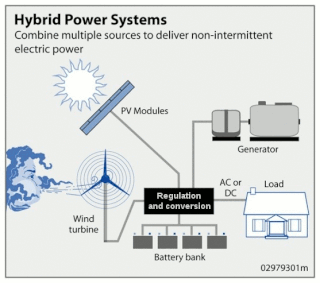
A stand-alone power system, also known as remote area power supply (RAPS), is an off-the-grid electricity system for locations that are not fitted with an electricity distribution system. Typical SAPS include one or more methods of electricity generation, energy storage, and regulation.

A photovoltaic system, also PV system or solar power system, is a power system designed to supply usable solar power by means of photovoltaics. It consists of an arrangement of several components, including solar panels to absorb and convert sunlight into electricity, a solar inverter to convert the output from direct to alternating current, as well as mounting, cabling, and other electrical accessories to set up a working system. It may also use a solar tracking system to improve the system's overall performance and include an integrated battery solution, as prices for storage devices are expected to decline. Strictly speaking, a solar array only encompasses the ensemble of solar panels, the visible part of the PV system, and does not include all the other hardware, often summarized as balance of system (BOS). As PV systems convert light directly into electricity, they are not to be confused with other solar technologies, such as concentrated solar power or solar thermal, used for heating and cooling.
The nominal power is the nameplate capacity of photovoltaic (PV) devices, such as solar cells, modules and systems, and is determined by measuring the electric current and voltage in a circuit, while varying the resistance under precisely defined conditions. The nominal power is important for designing an installation in order to correctly dimension its cabling and converters.

A thin-film solar cell is a second generation solar cell that is made by depositing one or more thin layers, or thin film (TF) of photovoltaic material on a substrate, such as glass, plastic or metal. Thin-film solar cells are commercially used in several technologies, including cadmium telluride (CdTe), copper indium gallium diselenide (CIGS), and amorphous thin-film silicon.
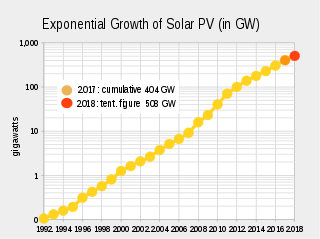
Worldwide growth of photovoltaics has been close to exponential between 1992 and 2018. During this period of time, photovoltaics (PV), also known as solar PV, evolved from a niche market of small scale applications to a mainstream electricity source.
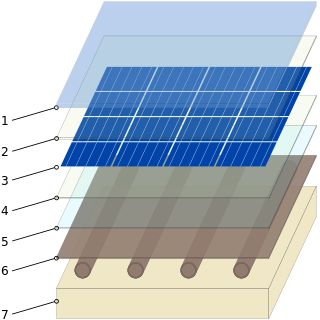
Photovoltaic thermal collectors, typically abbreviated as PVT collectors and also known as hybrid solar collectors, photovoltaic thermal solar collectors, PV/T collectors or solar cogeneration systems, are power generation technologies that convert solar radiation into usable thermal and electrical energy. PVT collectors combine photovoltaic solar cells, which convert sunlight into electricity, with a solar thermal collector, which transfers the otherwise unusued waste heat from the PV module to a heat transfer fluid. By combining electricity and heat generation within the same component, these technologies can reach a higher overall efficiency than solar photovoltaic (PV) or solar thermal (T) alone.
A power optimizer is a DC to DC converter technology developed to maximize the energy harvest from solar photovoltaic or wind turbine systems. They do this by individually tuning the performance of the panel or wind turbine through maximum power point tracking, and optionally tuning the output to match the performance of the string inverter. Power optimizers are especially useful when the performance of the power generating components in a distributed system will vary widely, such as due to differences in equipment, shading of light or wind, or being installed facing different directions or widely separated locations.

Turkey is located in an advantageous position in the Middle East and Southeast Europe for solar energy. Solar potential is very high in Turkey, especially in the South Eastern Anatolia and Mediterranean provinces. Compared to the rest of the region, insolation values are higher and conditions for solar power generation are comparable to Spain. 7.5 TWh was generated in 2018 which was 2.5% of Turkey's electricity. Installed capacity was 5GW, with the Energy Ministry planning to have another 10GW installed in the 2020s. However solar power in Turkey could increase far more quickly if subsidies for coal were abolished and the auction system was improved.

Crystalline silicon (c-Si) is the crystalline forms of silicon, either polycrystalline silicon, or monocrystalline silicon. Crystalline silicon is the dominant semiconducting material used in photovoltaic technology for the production of solar cells. These cells are assembled into solar panels as part of a photovoltaic system to generate solar power from sunlight.

Concentrator photovoltaics (CPV) is a photovoltaic technology that generates electricity from sunlight. Unlike conventional photovoltaic systems, it uses lenses or curved mirrors to focus sunlight onto small, highly efficient, multi-junction (MJ) solar cells. In addition, CPV systems often use solar trackers and sometimes a cooling system to further increase their efficiency. Ongoing research and development is rapidly improving their competitiveness in the utility-scale segment and in areas of high insolation.
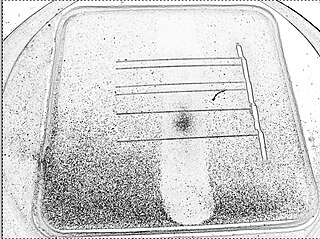
Solar cell efficiency refers to the portion of energy in the form of sunlight that can be converted via photovoltaics into electricity by the solar cell.

A rooftop photovoltaic power station, or rooftop PV system, is a photovoltaic system that has its electricity-generating solar panels mounted on the rooftop of a residential or commercial building or structure. The various components of such a system include photovoltaic modules, mounting systems, cables, solar inverters and other electrical accessories.

A grid-connected photovoltaic system, or grid-connected PV system is an electricity generating solar PV power system that is connected to the utility grid. A grid-connected PV system consists of solar panels, one or several inverters, a power conditioning unit and grid connection equipment. They range from small residential and commercial rooftop systems to large utility-scale solar power stations. Unlike stand-alone power systems, a grid-connected system rarely includes an integrated battery solution, as they are still very expensive. When conditions are right, the grid-connected PV system supplies the excess power, beyond consumption by the connected load, to the utility grid.
Potential-induced degradation (PID) is a potential-induced performance degradation in crystalline photovoltaic modules, caused by so-called stray currents. This effect may cause power loss of up to 30 percent.
The history of photovoltaic growth includes previous forecast and annual deployment figures by country.
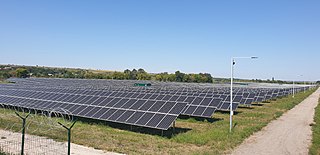
Multiple different photovoltaic module analysis techniques are available and necessary for the inspection of photovoltaic (PV) modules, the detection of occurring degradation and the analysis of cell properties.